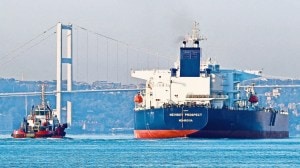Turnaround in three years
December 12: Three years is too short a period for a turnaround in the life of a city. But not for Ahmedabad. In 1994, the cash-starved mun...

December 12: Three years is too short a period for a turnaround in the life of a city. But not for Ahmedabad. In 1994, the cash-starved municipal corporation was struggling to make anyone pay octroi, the roads in the city were ordinary even by Indian standards. Three years down the road, Ahmedabad is an urban success story.
The city has excellent roads, its budget has risen from Rs 370 crore in 1994 to Rs 786 crore in 1997; a civic body that was in the red till 1994 expects to mop up a surplus of about Rs 103 crore this year. The World Bank is planning a model based on Ahmedabad that could be implemented in other developing countries. And the AMC is all set to launch a Rs 100-crore municipal bond, the first of its kind in the country.
Muni bond? The seven-year bond, conceptualised by Earl Kessler, an urban planner with the US Agency for International Development, is expected to finance sewer and water projects in the city. CRISIL has rated the bond issue as A-plus. The issue was planned for August, but was delayed because the AMC was waiting for the interest rates to be slashed. "We are hopeful of launching the issue some time in the first week of January," says B.K. Sinha who took over as municipal commissioner in September.
Behind the turnaround is the story of realistic and forward-looking urban planning. When Keshav Verma, then Municipal Commissioner, set out in end-1994 to change the city, he knew that he would have to take some tough decisions. "I soon realised that I had to handle a classic case of a rich city and a poor municipal corporation," he says.
The biggest challenge came from the octroi mafia, which had a stranglehold on the system. The mafia-trader nexus was so deep that the staff could only look on as the AMC’s revenue diminished rapidly. So, within a week of his taking charge, Verma and a core group of senior officials — with the help of the police — chalked out a plan to plug leaks at octroi posts.
"We started stopping vehicles owned by the main offenders, and even had many of them arrested. Others went underground. This clearly sent a signal to their colleagues," says former deputy municipal commissioner P.U. Asnani. The result: In one month, daily octroi revenue doubled to Rs 60 lakh.
By March 1995, the corporation registered a net surplus of Rs 1 crore. The administration realised that roads were the route to effect a change in the popular perception of the municipality. The AMC began to pay more attention to infrastructure. The engineering department was geared up to expedite work, a process helped by the fact that the department’s budget now increased from a few lakhs to some crores.
Verma had one advantage: the absence of a political wing in the corporation, as it was the administrator’s rule in the corporation. "Because of this, we could arrive at and execute decisions quickly. With a cooperative administrator, our schemes would be cleared in half an hour," says Asnani.
Verma had another battle to fight, though: his staff. He decided to professionalise the AMC’s cadre by completely upgrading and changing the qualification for managerial posts. Today, officers must have degrees in business administration, accountancy or environmental engineering. To infuse new blood into its cadre, direct recruitment up to 30-50 per cent was made mandatory. Today, there are more than 200 professionals who have been appointed assistant managers.
This, in a civic body, was unheard of, and the reactions expected. Unions made every attempt to scuttle Verma’s plan. "We suspended several union leaders and kept on the path to reforms," says Verma. However, the opposition died down soon.
The AMC decided to plan long-term, a departure from ad-hocism. "I see the city as a long-term corporate plan, which is spread over 20-30 years. Even our annual budget reflects a perspective of 10 years," Verma says. And all of AMC’s planning is being done keeping in mind year 2021.
Also, Verma took up some uncommon projects based, for instance, on the concept of urban partnerships. As a result, CG Road, which essentially houses shopping complexes and eateries, was developed in partnership with a corporate house and a chaotic road was transformed with parking lots, spacious sidewalks and street-lights.
In an effort to bring the city’s poor — a sizeable 41 per cent of the total population — the AMC launched the Slum Networking Project, done in partnership with slum-dwellers, non-government organisations and corporate firms. The project aims at giving the residents physical and social infrastructure including individual toilets, regular water supply, storm-water drains, street lights, sewerage system and internal roads. A pilot project has been completed, and assistance may be available from the World Bank and the Asian Development Bank.
Verma, however, believes that cities have to build their own capacities; they cannot afford to run to the State Government every now and then with a begging bowl. This year alone, the AMC hopes to mop up about Rs 50 crore from water charges, which have been hiked.
But still there are areas where the AMC has to struggle to achieve results. The most serious of them is pollution. The Sabarmati river has turned into a sewer with dirt and industrial effluents being released into it. The AMC now has taken up a project to clean up the river under National River Conservation Plan. The Rs 100-crore plan involves making new sewage treatment plants and raising the capacity of sewerage-lines.
Though the AMC has succeeded in raising its revenue manifold, it has not been able to check the powerful builder-lobby that flouts all building by-laws. Another city problem is its chaotic traffic. The AMC has already undertaken a Rs 67-crore project to widen the existing four bridges, make three new flyovers and as many underpasses.
Though Ahmedabad has changed dramatically in the past two years, Verma thinks it has a long way to go. "Ahmedabad should become the centre of education. It should have excellent hospitals, lovely public places and an efficient public transport system. And it should have clean air," he says. Sinha, who took over from Verma this September, has picked up from where his predecessor left. In the new development plan for the areas around the city, which was finalised recently, the corporation has created Special Development Districts, where floor space index (FSI) up to four (from present 1.5) would be allowed. The AMC will charge for every extra FSI. "This will lead to optimal use of land, and will fetch us extra revenue, too," Sinha says.
He brushes aside criticism that the AMC had pampered the affluent western part of the city and neglected the poor eastern areas. "No it is not true. In fact, when our sewerage and water-supply project worth about Rs 250 crore is finally implemented, it will be the eastern areas which will be the main beneficiary," he says.



- 01
- 02
- 03
- 04
- 05




























